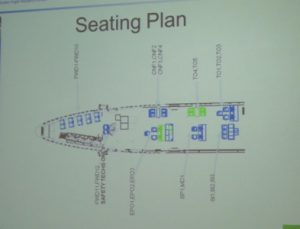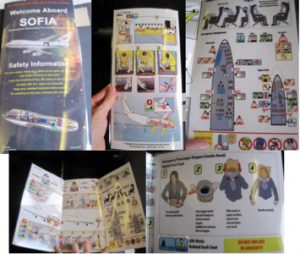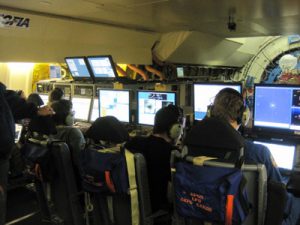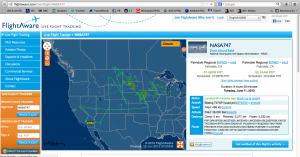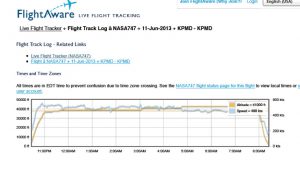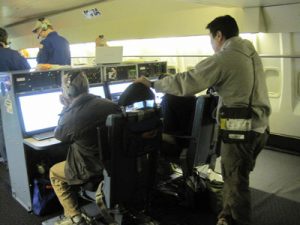Reposted from https://blogs.nasa.gov/mission-ames/2013/06/12/post_1371070856575/.
After boarding, we had some time before the doors closed. A safety briefing was held. Upon entry to SOFIA, one objective, as this was a relatively “full flight” with 30 people, was to stake out a seat for take off(a comment was even made of the ‘Southwest Airlines’ way). Seats are scattered about the airplane for specific purposes and prior to this flight, my colleagues and I had worked out our seating. We could only send one representative to the “conference table” seating area, so Martin Garay (a student at Ithaca College) and I were sent to business class, while Luke Keller (our grism lead, astronomy professor at Ithaca College) sat at the “conference table” midway along the telescope deck.
Sketch of the seating on the telescope deck on SOFIA. There are additional seats on the upper deck.
During the prep for takeoff, I took the moment to inspect the on-board safety information card. It re-iterated what we learned in egress training and what was described as we boarded. Indeed the inside of this 747SP is very different from your normal airline experience and being aware of your surroundings wherever you are is important.
Compilation of photos of the SOFIA on-board safety information card.
The engines started at 715pm PDT (local time), and we took off around 7:27pm PDT. It was a good 50 seconds for takeoff. And essentially, it felt like a normal jet takeoff sitting up in the business class section.However, unlike a normal airline ride, within a few minutes we were allowed to get out of our seats. It was just so surreal to be walking down/up the plane during the descent. It sort of felt wrong, as we are accustomed to the strict rules on commercial aircraft, but it was so important to use any leg designed to bring the aircraft to the 40,000 ft science altitude, to do non-science things like setting up computers and testing connections between the systems. On this flight, every second counts! And that theme was certainly reiterated throughout the night.
By 8pm PDT we were at 35,000 ft. The pilots had already completed 3 legs of a 13-leg flight plan.
And at 825pm PDT, the telescope door opened! Within minutes, Joe Adams, the FORCAST lead instrument scientist, had started his first script to check out the detector frame rate settings.
One of the first data acquisitions of SOFIA Flight #105. Target is R Leo.
We hit pockets of turbulence during ascent and near the “weather” areas we had been warned about, and although the aircraft seemed to be moving up/down/sideways, the telescope moved as well. It was mesmerizing to see the FORCAST instrument and its counter weight moving about the cabin and yet the position of the star in the telescope guide camera was “rock solid.” Indeed, contents shifting during flight, but not this telescope! Two times during the light, the turbulence got bad enough that we had to return to our seats and the telescope was “secured,” but both episodes lasted less than 10minutes.
From Jim Debuzier’s (the lead instrument scientist) log, hewrote: “09:45 [UTC] Turbulence like a roller coaster. Everyone’s sitting (whether they wanted to or not), and the telescope is in local. Riding it out until we can start observing again…)”
What was fascinating was that according to the mission manager, we probably lost about an hour due to turbulence. We had to sit down about 2x during the flight for a period of 10-15 minutes. I lost all track of durations of things, as I was focused on what data we lost by these unexpected interruptions. But each time we faced turbulence, we just took it in stride.Around 08:20 UTC (1:20am PDT) we also needed to do small flight diversion from our Leg #9 to avoid some baby tornado clouds. This time the timing was good as we were doing some calibration flats which did not need a target so we could still take data during the diversion.
You can see what the actual flight path was by visiting http://flightaware.com and searching on NASA747.
Screengrab of actualSOFIA Flight#105 flightpath Jun 11-12, 2013 from Flightaware.com
Screengrab of logged SOFIA altitude and speed for Flight #105 Jun 11-12, 2013 from Flightaware.com
Kudos to the pilots for giving us a very good flight and working with the weather patterns!
One thing to mention, as we were free to move about the cabin, each of us had to carry with us a EPOS, emergency passenger oxygen system. In case there was a depressurization at 40,000ft, there would not be enough time to get to the nearest seat for oxygen masks. It was a small nuisance to carry a bag with you everywhere, but it did not get in the way of getting the work done, planning, executing, and analyzing the data on the instrument.
One of the passengers, a member of the DAOF staff, carrying his EPOS, the khaki-green pouch on a shoulder strap.

